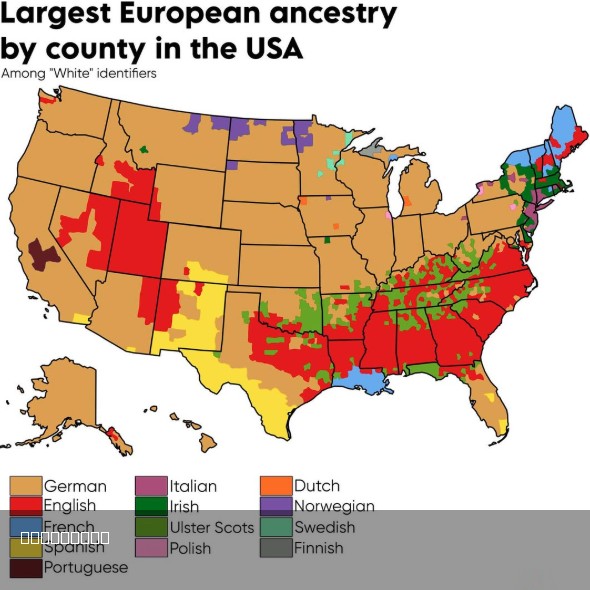Largest European Ancestry in the US Map


Marcus Rodriguez
Historical Geography Expert
Marcus Rodriguez specializes in historical cartography and geographic data analysis. With a background in both history and geography, he brings unique...
Geographic Analysis
What This Map Shows
The "Largest European Ancestry in the US Map" provides a detailed visualization of the distribution of European ancestry across the United States. It highlights which states and regions have the highest concentrations of various European ethnic groups, giving us insight into the demographic tapestry that shapes American society today. By examining this map, we can understand how historical migration patterns have influenced the cultural landscape of the United States.
Deep Dive into European Ancestry in the US
European ancestry is a significant part of the demographic makeup of the United States, largely due to historical immigration waves that began in the 1600s and continued through the 20th century. The map illustrates that Irish, German, English, and Italian ancestries are among the most prominent in the country. For instance, states like Massachusetts and New York have a high percentage of Irish ancestry, while states like Wisconsin and Minnesota showcase substantial German roots.
Interestingly, the reasons behind these concentrations can often be traced back to historical events. The Great Famine in Ireland in the mid-19th century led to a massive influx of Irish immigrants to the U.S., particularly in cities like Boston and New York. Similarly, the industrial revolution attracted many Germans seeking work, leading to their significant presence in the Midwest.
Have you noticed that the distribution of these ancestries is often not uniform? For example, while the South has a notable presence of English ancestry, it also exhibits a rich tapestry of other European influences due to its unique history involving settlement, slavery, and migration. In fact, places like Virginia and the Carolinas are rich in English heritage, which is a remnant of early colonial settlements.
Moreover, the map shows that Italian ancestry, while less prevalent than Irish or German, is concentrated in specific regions, such as New York and New Jersey, reflecting the waves of Italian immigration in the late 19th and early 20th centuries. This concentration has contributed to the cultural fabric of these areas, influencing local cuisine, festivals, and community identities.
The nuances of European ancestry in the U.S. are also reflected in the linguistic landscape. Many communities maintain their heritage through language, with Italian and Irish Gaelic being spoken in certain enclaves, preserving ties to their ancestral roots.
Regional Analysis
Let's break down the map by regions to see how European ancestry varies across the United States. In the Northeast, states like Massachusetts and Connecticut show a heavy predominance of Irish ancestry, with approximately 20-25% of the population claiming Irish roots. This is in stark contrast to the Midwest, where German ancestry prevails, especially in states like North Dakota and Nebraska, where it can be as high as 30%.
In the South, English ancestry is most prominent, particularly in Virginia and Alabama, where many residents can trace their lineage back to early colonial settlers. This is fascinating because it highlights how historical migration patterns create distinct regional identities. Interestingly, the data indicates that while states in the Northeast and Midwest are often seen as the historical heartlands of these ancestries, the South has developed a unique identity that intertwines European ancestry with African American heritage, reflecting a complex social history.
The West presents another interesting case. Here, European ancestry is more diverse, with significant populations of Irish, German, and even Scandinavian descendants, particularly in states like California and Washington. The map reveals that while these ancestries are prominent, they exist alongside a rich tapestry of Hispanic and Asian ancestries, showcasing the melting pot that America has become.
Significance and Impact
Understanding the distribution of European ancestry in the U.S. is essential for several reasons. Firstly, it helps illuminate how cultural identities are formed and maintained, influencing everything from politics to social norms. For instance, areas with a high concentration of Irish Americans have unique voting patterns and community organizations that reflect their heritage.
Moreover, this map serves as a vital tool for sociologists and historians who study the impact of immigration on American society. As we continue to see shifts in population dynamics due to globalization and modern migration patterns, understanding historical contexts can provide insights into current trends.
Looking ahead, the implications of these ancestral distributions could shape discussions about identity and community in the future. As America continues to evolve, the interplay between various ancestries will undoubtedly continue to influence the cultural landscape, potentially leading to new hybrid identities and social movements.
In conclusion, the "Largest European Ancestry in the US Map" isn't just a static representation of where people come from; it's a vibrant reflection of the historical and cultural forces that have shaped this nation. By examining the patterns and trends in European ancestry, we can better appreciate the rich, diverse heritage that makes up the United States today.
Visualization Details
- Published
- August 5, 2025
- Views
- 94
Comments
Loading comments...